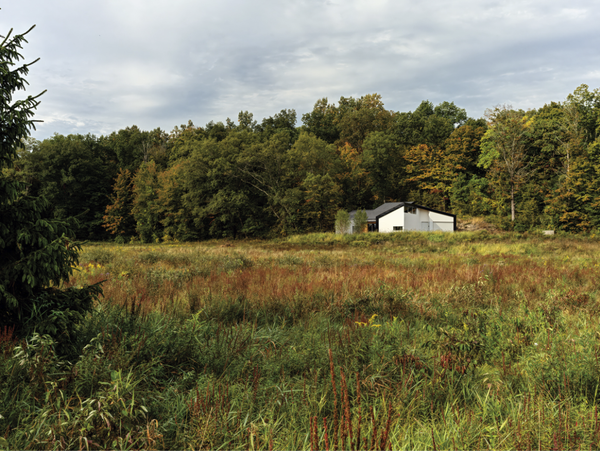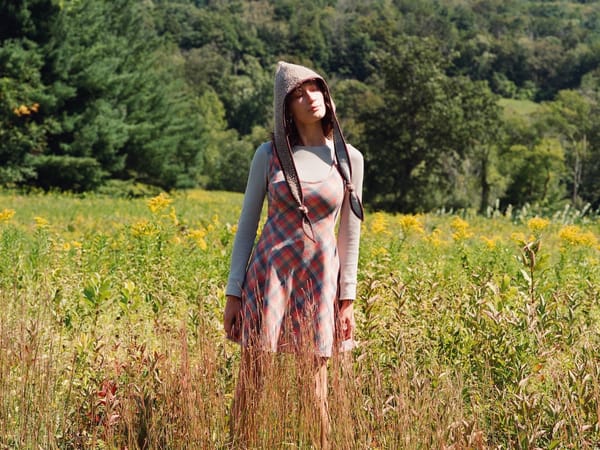Bauhaus Farmland: Gentle Curves in Germantown
The exterior hues and gently curved structure were informed by owner Miranda Fengyuan Zhang’s trip to China’s Huizhou province.

The exterior hues and gently curved structure were informed by owner Miranda Fengyuan Zhang’s trip to China’s Huizhou province.

Like many New Yorkers, Miranda Fengyuan Zhang’s mind began to wander north during Covid. The full-time weaving, ceramics, sculpture, and film artist was isolating with her father in her Manhattan apartment, and the city was “kind of dead,” she recalls.
In the midst of researching and visiting locations upstate, Zhang initially toyed with the idea of buying property in Catskill, which her father found a bit “too rural, too raw,” she says. (Her dad, now retired, divides his time between China and New York, while her mother still resides in China and visits a few times a year). However, while exploring the east side of the Hudson, they found themselves sharing a meal at the now-defunct restaurant Gaskins in Germantown. Zhang found the modest town center “very small, but cute,” and decided to browse available properties in the town on their way back into the city.

The monochromatic exterior hues and gently curved structure were informed by homeowoner Miranda Fengyuan Zhang’s trip to China’s Huizhou province.
“Everything was coming naturally. We weren’t so crazy about a specific location—we were looking at a lot of different places,” says Zhang, who came to New York from Shanghai for college a little over a decade ago and has lived here since. “It was more about serendipity.”
Zhang ended up falling in love with a 20-acre parcel in Germantown comprising a swath of flat farmland, as well as a small, forested hill at the top of the plot, replete with deciduous trees. Destiny took over, and Zhang decided this was the place to build her residence and artist studio. (She has since sold 10 of her 20 acres to her mother’s business partner, who plans to build another house on the plot.)
“It just has this very magical American landscape,” says Zhang. “It has a little hill that’s not super high altitude, and when you go to my plot, you have to go through this farming land—you see corn on the one side, fruit trees on the other side, and then you see a lot of farmhouses.”

Zhang’s upstairs bedroom leads out to its own private terrace overlooking the wooded hill behind the house.
For the build, Zhang enlisted Koray Duman of the Buro Koray Duman architecture firm, based in New York City and Istanbul. The two met through a mutual art world connection, Candice Madey, who hosted a show inside a gallery that Duman had designed.
Duman says he worked on plenty of residential renovations in the early days of his firm, but eventually he moved toward designing mostly arts and cultural institutions in New York City—including the Center for Arts and Advocacy, several Lower East Side galleries, and the Islamic Cultural Center, to name a handful. Along the way, Duman was charged with erecting and/or renovating various arts-related spaces in the Hudson Valley, including an award-winning storage and exhibition space for artist Richard Prince on a 250-acre plot.
Since Zhang’s biggest priority in conceptualizing the structure was having ample studio space—Manhattan, she admits, is “quite limited” in this respect—Duman was a natural fit for the job.
Duman sited the 2,500-square foot structure at the intersection of the plot’s flat farmland and forested hill, which provides views of both landscapes. The house has two distinct zones, with the weaving and ceramics studio on its north side. The living spaces are on the west side, including a modest kitchen; two bedrooms, two bathrooms, and an open-plan living/dining room with a cozy wood-burning stove. The studio and living spaces are connected by a large deck, which Zhang cites as her favorite feature of the home.

The open-plan living and dining area is decorated according to Zhang’s Bauhaus-inspired taste. A vibrant woven throw by Zhang is slung over the couch.
“The scale of the [studio] space is not big, but the height of it gives you space to think and experiment with your thoughts,” says Duman. He adds that the studio, sitting at a right angle from the rest of the home and complete with a cutout window overlooking the farmland where Zhang’s desk sits, brings in ample northern sunlight, which he describes as “never harsh. It’s never direct, but there’s always natural light coming. It was important to bring that constant, continuous light without making it too destructive.”
Duman designed the house with several ecofriendly features, including geothermal heating and cooling; a super-tight envelope; a high-performing efficient glass door system from German manufacturer UNILUX; and building the storage garage into the earth of the hillside for passive climate control. Additionally, the high-ceilinged living room was equipped with fans that blow in two directions to provide maximum cross ventilation.
Duman says he and Zhang tackled the project as a play on the traditional A-frame barn vernacular design. In this sense, one of the home’s most striking features is its rounded curve shape that separates the living spaces from the studio. Duman says this divide was originally conceptualized as a sharp right angle, but in conversations with Zhang, the two decided “the home needed some softness to it, rather than almost cut-and-folded.”

A sculptural wooden staircase anchors the interior of Miranda Fengyuan Zhang’s Germantown home, flanked by built-in shelves displaying a minimalist, museum-like arrangement of books, art, and personal objects.
The curved structure also serves as a cultural nod to Asian architecture, which greatly informed the exterior hues, as well. Aesthetically, Zhang—having recently visited China’s Huizhou province as the design and build of her home and studio commenced—was inspired by the monochromatic palettes of the ancient region’s architecture, which consists almost entirely of white concrete facades and black-stained cedar shingle roofs, a look echoed in the Germantown property.
“Miranda’s aesthetics are geared very much toward almost no color,” says Duman. This is also echoed in Zhang’s choice of interior furnishings, which Duman describes as “very restrained and modern.”
“I wanted it to be very minimal—leather, chrome, white, a little bit of wood,” adds Zhang, noting that she imported much of her vintage furniture from Brussels after visiting the country with her mother. “I’m a Bauhaus girl, so everything is pretty much following that. I want the furniture to be almost serene, almost like an office space.” This was especially important to Zhang because her artwork, which adorns the walls of the home, is very “soft,” and thus she desired her furnishings to be a “quiet and serious” foundation for the art.

Zhang’s minimalist and Zen-inducing bedroom includes her own artwork on the wall, as well as a 1980 plywood puzzle chair; a bedside hopscotch case with Jonah Art by Sawkille Co.; a built-in custom closet designed by Buro Koray Duman, built by Montana Contracting; and a manual shade by Blindtek Designer Systems over UNILUX aluminum-clad wood windows.
Zhang also fantasized about having a space where her father could maintain a vegetable garden, as she says her parents have never lived in a countryside setting before.
“In a way, I wasn’t so much focusing on the design aspect, but more on the functional side of it,” Zhang says. “I wanted the house to be low key—something not too showy. I wanted a modern house, but at the same time, I do want it to be almost like a blank canvas; something not so intrusive to the landscape, that I can gradually build something within.”
To that end, Zhang says the next phase she envisions for her home is to share it with others. This summer, she hopes to begin this process by collaborating with galleries in the city to curate shows and eventually open her home to fellow creators on the weekends.

The cozy high-ceilinged living room, also with Zhang’s artwork adorning the walls, boasts a sleek Nova 2 wood-burning stove from MF Fire and an upright piano.
“My goal, since I have a lot of space now upstate, is to use it as a platform to show something interesting,” says Zhang. “As an artist, I’m always so focused on my studio practice. But at the same time, I feel if you have a really good space, it’s important to know how to share the space, too. So, I think that will probably be the goal for this year—sharing the space with people and showcasing their works, building conversation, and giving context to the space, instead of it being purely private and residential.”








